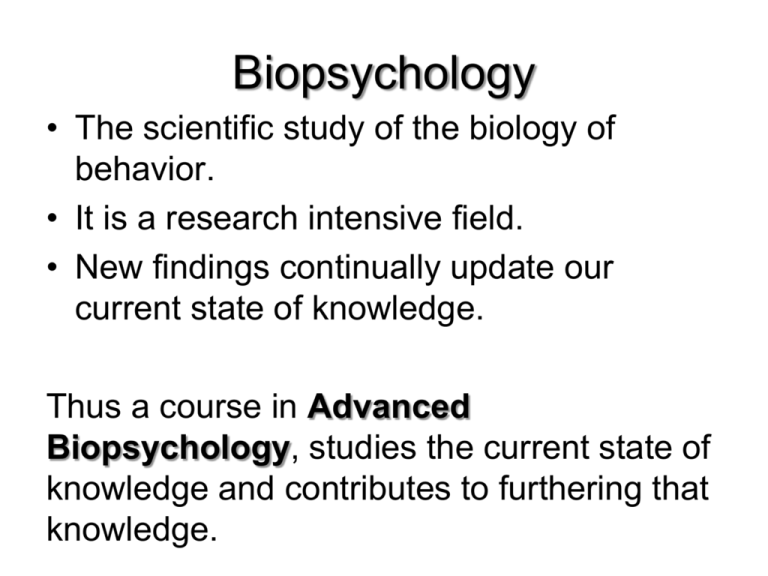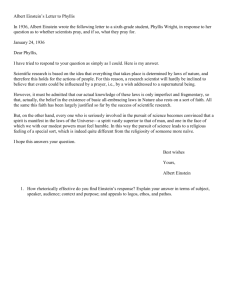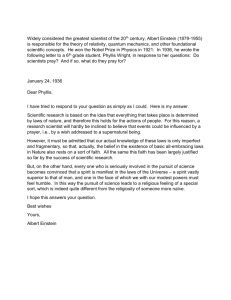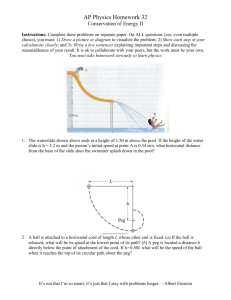Intro slides
advertisement

Biopsychology • The scientific study of the biology of behavior. • It is a research intensive field. • New findings continually update our current state of knowledge. Thus a course in Advanced Biopsychology, studies the current state of knowledge and contributes to furthering that knowledge. Pop Quiz: true/false 1. Everyone is born with all the neurons they will have throughout life, what changes are the connections between them. 2. When neurons of the CNS die they are not replaced. 3. Glial cells provide the ‘glue’ that holds neurons in place but do not directly communicate with other cells. 4. Paralysis from stroke is permanent with minimal functional restoration. Dewsbury (1991) The “biology” in “psychobiology” should include the whole-animal approaches of ethology, ecology, evolution…as well as the latest in physiological methods and thought…. The “compleat psychobiologist” should use whatever explanatory power can be found with modern physiological techniques, but never lose sight of the problems that got us going in the first place: the integrated behavior of whole, functioning, adapted organisms. (p. 198). Dewsbury, D.A. (1991). Psychobiology. American Psychologist, 46, 198-205. Biopsychology – the scientific study of the biology of behavior (Dewsbury, 1991). • Psychobiology • Behavioral biology • Behavioral neuroscience • Physiological psychology It denotes a biological approach to the study of psychology (the scientific study of behavior). “Although it is not possible to specify the exact date of biopsychology’s birth, the publication of The Organization of Behavior in 1949 by Donald Hebb played a key role in it’s emergence.” Karl Lashley (1890-1958) • Coined the term “neuropsychology” • Studied the effects of cortical lesions on learning performance in rats with the goal of finding the “engram” or locus of a memory trace. • Principle of “equipotentiality” • Principle of “mass action” Phrenology • Franz Joseph Gall (~1800) • Personality traits can be determined by measuring protrusions or bumps on the skull. • Although the methodology was discredited as a pseudoscience, it did advance the idea that certain functions may be localized to specific brain regions. Multiple memory systems • Current research supports localization of function… • E.g., Different types of learning – Behaviorism (S-R) – Cognitivism (S-S) • Neuropsychological evidence compellingly demonstrates that different brain regions mediate cognitive and associative learning. Can one localize ‘intelligence’ Once thought to be the complex function of the prefrontal cortex, until… • Phineas Gage Is the ‘Genius brain different? Can ‘genius’ really be quantified by neuroscientists? Several publications have reported differences between Einstein’s brain compared to ‘normal’ control brains, which has led to some debate among scientists. References: 1. Diamond, M.C., et al., 1985. On the brain of a scientist: Albert Einstein. Exp Neurol 88, 198-204. 2. Kantha, S.S., 1992. Albert Einstein's dyslexia and the significance of Brodmann Area 39 of his left cerebral cortex. Med Hypotheses 37, 119-122. 3. Anderson, B., Harvey, T., 1996. Alterations in cortical thickness and neuronal density in the frontal cortex of Albert Einstein. Neurosci Lett 210, 161-164. 4. Galaburda, A.M., 1999. Albert Einstein's brain. Lancet 354, 1821; author reply 1822. 5. Hines, T., 1998. Further on Einstein's brain. Exp Neurol 150, 343-344. 6. Salvatori, R., 1999. Albert Einstein's brain. Lancet 354, 1821-1822. 7. Seitz, J.A., 1999. Albert Einstein's brain. Lancet 354, 1822-1823. 8. Colombo, J.A., et al., 2006. Cerebral cortex astroglia and the brain of a genius: a propos of A. Einstein's. Brain Res Brain Res Rev 52, 257-263. A strange journey The brain-snatcher: Thomas Harvey The driver: Michael Paterniti The passenger: Einstein’s brain “Anticlimactic endings are like taking your dog for a walk only to watch him urinate on your rug when you come back home. Not that the walk itself wasn’t enjoyable, just that the end result leaves a lot to be desired.” Review: Horowitz, S. (2000). Driving Mr. Albert: A trip across America with Einstein’s brain, by Michael Paterniti. Nature Medicine, 6, 1090. Recommended Text Brian Burrell (2005) Chapter 14: Einstein’s Brain NPR interview with Burrell http://www.npr.org/templates/story/story.php?storyId=4602913 The book includes an excellent critical review of the scientific studies performed with bits of the brain. For example… Diamond et al., 1985 One out of 28 results were significant (p<.05): Einstein had a smaller neuron-toglial cell ratio in area 39 of the left hemisphere. Concluded that, like rats exposed to an enriched environment, Einstein had more glial cells to support neurons in a brain region mediating visuospatial and math functions. Many flaws with the study: unspecified control, questionable data selection, transformation and statistical tests etc. Maybe the glial cells were increased because of early damage related to Einstein’s delayed language development A picture is worth a million $ “A. Einstein's astrocytic processes showed larger sizes and higher numbers of…bulbous endings...of unknown significance and they have been described occurring in Alzheimer's disease. These observations are placed in the context of the general discussion regarding the proposal – by other authors – that structural, postmortem characteristics of the aged brain of Albert Einstein may serve as markers of his cognitive performance, a proposal to which the authors of this paper do not subscribe, and argue against.” Lessons Review research carefully, even studies published in peer reviewed journals. …is the rationale sound? …are the methods used appropriate? …is the interpretation justified? Healthy skepticism = good science Localization of function • Is still an open question • As consumers of science, you should be a discerning critic of research findings • neo-phrenology or something more • Brains and behavior are incredibly complex… The brain paradox Flex your mental might… It’s all in how you use it Duhh, donut Biopsychology in the news • • • • • http://www.npr.org/ http://www.biopsychology.com/ http://www.brainconnection.com/ http://www.sfn.org/ http://www.dana.org/braincenter.cfm Thinking about the Biology of Behavior Homersapien Evolution Genes GDE Current Organism Current Situation Development Experience Current Behavior Multiple levels of brain organization Behavior and Cognition Systems and Circuits Synapses and Neurons Genes and Molecules Why study behavior if the all the action is at the molecular and genetic levels? Answer: The proof is in the behavior A Drug company makes a major discovery! Would you take a longevity pill? The silver bullet of longevity that could extend your life by 50 years But what if there was no proof that it preserves cognitive function? Genes and Aging http://www.pbs.org/wgbh/nova/sciencenow/3401/01.html http://www.genesistoday.com/genesis_today_products/resv_berry_juice.html Product endorsement? Harvard Anti-Aging Researcher Quits Shaklee Advisory Board By KEITH J. WINSTEIN Wall Street Journal DECEMBER 26, 2008 http://online.wsj.com/article/SB123025446150734561.html At an August sales conference, Dr. Sinclair told Shaklee's salespeople that "over a year ago, we set out together to do this, to make a product that you could actually activate these genetic pathways that can slow down aging." In a video of the conference -- posted on the Internet -- he added, "Together, as part of the Shaklee family...we can take this technology right now, to our friends, to our family, and really have the benefits of this new technology right now, within our lifetimes, and you'll learn more about the Vivix product later." Resveratrol in red wine? Procyanidin – vitamin P http://www.nydailynews.com/life-style/health/hot-chocolate-fight-dementia-study-article-1.1421045 Blueberry flavonoids







